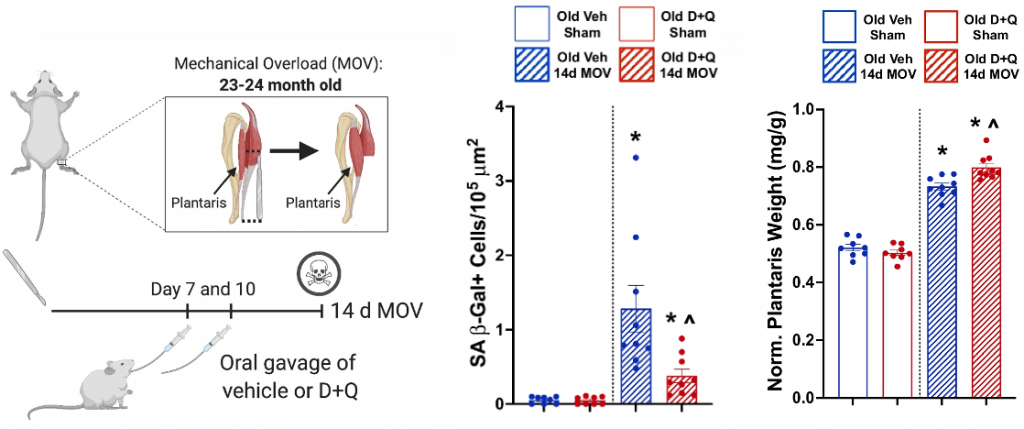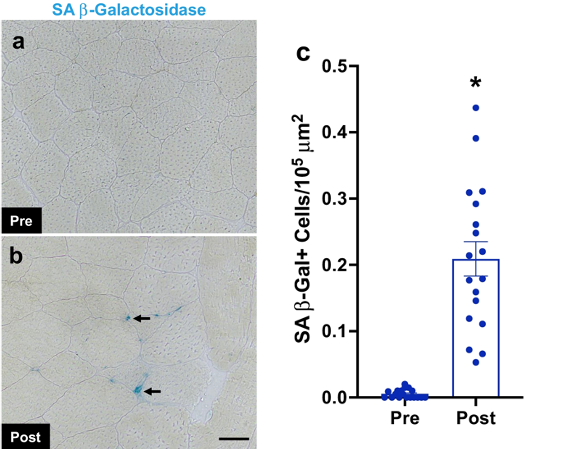Key Points:
- Old mice have high levels of senescent cells — zombie-like cells that accumulate with aging — and lack muscle growth in response to resistance exercise.
- Senolytics — compounds that kill senescent cells — restore muscle growth and diminish senescent cells in old mice.
- Senescent cells are present in human muscle after resistance exercise training.
Weightlifting is a common form of resistance exercise, ideal for preventing the gradual loss of muscle mass and strength that occurs with aging. However, due to a phenomenon known as anabolic resistance, the older we get, the harder it is to pack on muscle. The underlying reason for anabolic resistance is not fully understood, but a new study suggests that senescent cells play a key role.
In an article published in the journal GeroScience, Dungan and colleagues from the University of Kentucky show that treatment with senolytics helps prevent anabolic resistance in old mice. Specifically, the combination of two senolytics, Dasatinib and Quercetin (D + Q) eliminates senescent cells and restores age-related resistance to muscle growth in old mice. Furthermore, D + Q eliminates senescent cells in human muscle tissue, suggesting that D + Q could be used to treat older adults with anabolic resistance.
Senolytics Prevent Lack of Muscle Growth in Old Mice
To simulate resistance training in mice, Dungan and colleagues surgically removed the major calf muscles of the leg, leaving the plantaris muscle. Due to mechanical overload — overloading a muscle with more weight than usual — the plantaris grew after two weeks. However, the plantaris grew less in older mice than in adult mice, indicative of anabolic resistance. Additionally, the old mice had more senescent cells in response to mechanical overload, likely contributing to anabolic resistance. Treating old mice with D + Q restored muscle growth and reduced senescent cells, suggesting that senescent cells contribute to anabolic resistance, which can be treated with D + Q.

Exercise Increases Senescent Cells in Human Muscle
Previously, D + Q has been shown to extend lifespan, improve physical performance, and restore muscle regeneration in mice. Dasatinib and Quercetin are senolytics, an emerging class of drugs used to kill senescent cells. Senescent cells are growth-arrested cells that are protected from cell death, normally destroyed by the immune system. However, as we age our immune system becomes less efficient, allowing senescent cells to accumulate. Senescent cells secrete a host of molecules (known as SASP) that may contribute to anabolic resistance. Therefore, D + Q may be a viable therapy for anabolic resistance.
To test whether senescent cells may contribute to anabolic resistance in humans, Dungan and colleagues measured senescent cell levels from the thigh muscle of volunteers before and after resistance exercise. There were no signs of senescent cells before resistance training but senescent cells were apparent after one training session. These findings support the idea that senescent cells are induced by resistance exercise. It is hypothesized that the immune system destroys these senescent cells in young age but not old age, contributing to anabolic resistance.

Dasatinib plus Quercetin: A Killer Combo
The findings of Dungan and colleagues support the important role of senescent cells in anabolic resistance and demonstrate D + Q as a potential treatment. When senescent cells were first discovered, Mayo Clinic scientists screened for potential senolytic drugs that could easily be translated for human treatment. Among these drugs were Dasatinib, already used to treat cancer, and Quercetin, a naturally occurring flavonoid. Since then, D + Q has improved age-related deficits in the heart, lung, and bone of mice. Similar to Dungan and colleagues’ findings but in bone, a recent study showed that D + Q reduces the senescent cells induced by bone fracture, accelerating fracture healing in aged mice.
Human studies have shown that D + Q improves lung scarring and reduces senescent cells in the fat tissue of diabetic patients. Even Dasatinib alone has antidiabetic effects. D + Q also prevents inflammation of organs from older donors, optimizing their use for transplantation. Some of D + Q’s therapeutic effects may come from restoring the anti-aging protein α-Klotho. Furthermore, the results of a clinical trial for the treatment of Alzheimer’s disease with D + Q is awaiting publication. There are also more clinical trials on the way for the treatment of Alzheimer’s, and chronic kidney disease with D + Q. Overall, D + Q has a lot of potential for treating multiple age-related diseases.
When it comes to the role of senescent cells in anabolic resistance, there are still a few questions that need to be answered. For example, do senescent cells only build up in the muscle of individuals who exercise routinely? Otherwise, how are the senescent cells induced, considering that they don’t seem to be present in unexercised muscle? Since not all older adults suffer from anabolic resistance, there could be a correlation between exercise throughout a lifetime and senecent cells buildup/anabolic resistance. Of course, the primary question is if D + Q prevents anabolic resistance, which will likely be answered in a future study. If so, D + Q could be used in conjunction with weightlifting, or other resistance exercise protocols to treat anabolic resistance.